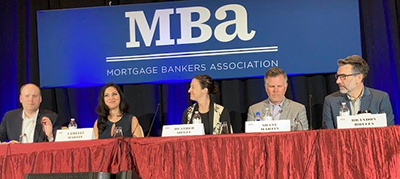
#MBATech2022: Where We Are on the Digital Journey

(l-r) Seth Appleton; Camelia Martin; Heather Siegel; Shane Martin; Brandon Hoyles.
LAS VEGAS—We have been hearing about digitalization of mortgages for years. What has been successful, and what has fallen short? Are lenders’ real-world results living up to the hype?
“We’ve seen a lot of businesses change,” said Seth Appleton, President of MISMO, speaking here at the MBA Tech Solutions Conference & Expo. “Services have drastically improved; we can get same-day delivery from Amazon. We’ve responded to consumer expectations.”
“The pandemic has resulted in the digital Band-Aid being ripped off,” said Camelia Martin, Head of Industry & Regulatory Affairs with Snapdocs, San Francisco. “Once the digital transformation took place—once the documents arrived electronically and the loan didn’t fall off the back of the FedEx truck—what we saw was the market responded—they started to accept eNotes, and they saw state after state passing Remote Online Notarization legislation. We’re not going backward—but now is the time to reinvest in digital technology to make it more scalable and easier.”
“It’s been fascinating seeing how our clients have changed their approach to digitization once the pandemic hit,” said Heather Siegel, Sales Representative with Qualia Labs Inc., San Francisco. “What we saw at the beginning of COVID was our customers coming to us to see how we could help them stay open. We’ve helped them push toward digitization and we saw that it’s something that consumers wanted, too.”
“We were having a hard time in 2016-2017 in getting people to use a digital application—it wasn’t how things were done,” said Brandon Hoyles, Title Sales Lead with Blend, San Francisco. “Now, some of these same people who wouldn’t use an application won’t pick up a phone to talk to a customer until they’ve completed an application electronically. The customer has become more comfortable in using technology for the front end of the loan. And it has elevated the role of the mortgage loan originator, because they are no longer simply taking down information—now they are an advisor to the consumer.”
Hoyles noted that the real estate finance industry tends to throw—and cast off—employees to respond to cyclical needs. “We added a lot of employees during the refi boom, and then when refis dried up, we let them go or shifted them to other spaces. It’s not easy to onboard people. We have to apply automation to address efficiencies—we can no longer have peaks and valleys; we have to have rolling hills.”
“We’re not in the mortgage business—we’re in the data business,” Camelia Martin said. “We’re just beginning to scratch the surface of getting that data upstream and then sharing it downstream with our vendors and customers.”
“The Holy Grail is that seamless, end-to-end mortgage experience,” Appleton said. “But it’s not going to turn on a dime in the industry; not every segment is going to turn at once.”
“We’ve all become digitized in every silo—but we’re still in siloes,” Siegel said. “We have to break down those siloes, while we still meet customer needs. It’s our obligation to come together across different systems to deliver that. I’m hopeful that we’ll see that in the coming years.”
“That is MISMO’s job,” Appleton said. “Bluetooth and Wi-Fi are examples of when competitors got together to create and maintain a standard. MISMO can do the same with the mortgage industry.
Shane Martin, Head of Sales for Digital Mortgage with Wolters Kluwer, Minneapolis, noted the first digital mortgage was completed in 2000 in Florida; since then, 1.65 million notes were created. “That sounds like a lot, but it isn’t,” he said. “It’s hard to quantify the benefits of the digital mortgage—companies want to know what the bottom line is.”
“You can’t really see the ROI if you aren’t able to interpret the data,” Camelia Martin said. “If you do a digital closing or send an eNote, it has to have interoperability. That is where the value of MISMO comes in, so investors have confidence in the data. It’s those standards that allow the transaction to have fungibility.”
The secondary market is critical to digital adoption, Shane Martin noted. “We currently have only 35 percent penetration in the warehouse industry, which puts us at a disadvantage,” he said. “We have to work with them to sort out their issues; we have to figure out how to help them.”
Appleton noted servicing—often at the back end of the mortgage process—is also seeing the benefits of digitization. “We can have a great experience up front, but if we’re not using it throughout the mortgage cycle, then we’re creating inefficiencies.”
“Servicing is still the place where data goes to die,” Hoyles quipped. “From the borrowers’ perspective, they’ve already done business with you once, so why do they need to give you all this information all over again? People understand how valuable their data are—and they want you to be careful about how you use it.”
“With more interest on the front end, we still find more information gets asked about on the back end,” Shane Martin said. “They need to understand that it is very simple and inexpensive to set up—they just have to enable it.”
“Nobody needs a buggy whip anymore,” Shane Martin added. “For the mortgage industry, it should be the same with paper. We need to make paper obsolete.”
“We currently live in an era in which we have to ask the consumer if they want a digital mortgage,” Camelia Martin said. “I want us to get to the point where the customer has to ask us if they want a paper mortgage; I want the complete digital mortgage to be the standard.”
